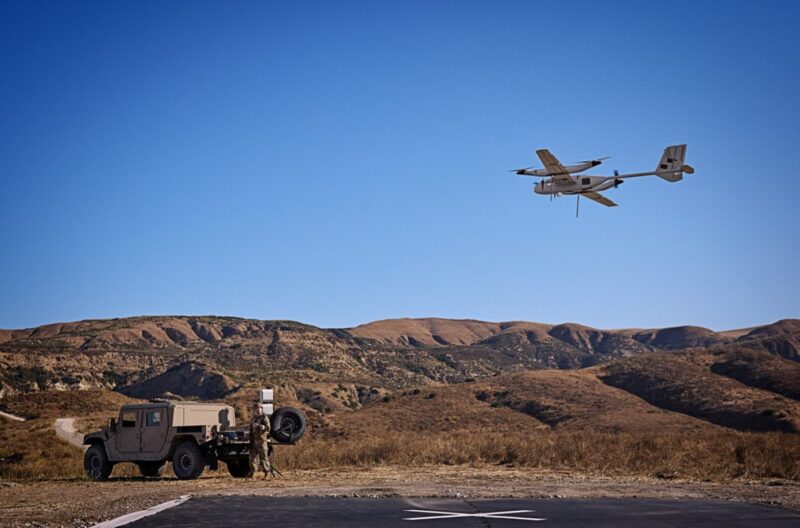AeroVironment Delivers First P550 Autonomous eVTOL Systems to U.S. Army
AeroVironment has delivered its pioneering P550 Autonomous eVTOL Systems to the U.S. Army, marking a significant advancement in military drone capabilities. This innovative drone is designed to enhance battlefield reconnaissance and facilitate rapid-response operations, representing both a technological and strategic achievement in defense innovation.
What Is the AeroVironment P550?
The P550 is an autonomous, electric vertical take-off and landing (eVTOL) drone built to meet the U.S. Army’s Long-Range Reconnaissance (LRR) program requirements. Categorized as a Group 2 small Unmanned Aircraft System (sUAS), it occupies a crucial role: agile, versatile, and quickly deployable, yet strong enough to execute demanding missions.
Key P550 Specs at a Glance
- Payload Capacity: Up to 15 pounds, suitable for various sensors, cameras, or small munitions.
- Endurance: Capable of up to 5 hours of sustained flight on battery power, setting a benchmark for tactical drones of this classification.
- Gross Take-Off Weight (GTOW): 55 pounds, balancing scale with payload capacity.
- Reconfiguration Time: Less than five minutes without tools—includes hot-swappable payloads and batteries for swift mission transitions.
- Architecture: Utilizes a Modular Open Systems Approach (MOSA) to support new payloads, radios, and batteries as missions and threats evolve.
- Autonomy & AI: Features built-in artificial intelligence for maneuvering, safety, situational awareness, and precise targeting.
How Does the P550 Change Battlefield Operations?
The P550 is tailored for dynamic arenas, where situations and mission needs change rapidly:
- Rapid Deployment: Soldiers can assemble or reconfigure the P550 in under five minutes, ensuring the technology meets immediate mission demands.
- Real-Time Adaptability: Allows seamless payload transitions from surveillance to strike capabilities within minutes.
- AI-Enhanced Operations: Integrated autonomy facilitates navigation, target selection, and tracking with minimal operator involvement.
- Modular Upgrades: Easily accommodates new technologies like sensors, radios, and batteries to stay ahead of adversaries.
- Increased Safety: Enhanced autonomy reduces operator risk, enabling remote launches and recoveries from challenging environments.
The Delivery: Not Just Hardware, But Teamwork
AeroVironment’s strategy focuses not only on delivering advanced technology but ensuring its effectiveness in operational theaters through:
- Comprehensive Training: Field service representatives offer extensive training for both users and maintainers.
- “Train-the-Trainer” Model: Army Master Trainers undergo advanced training to expediently impart skills across units.
- Integration Support: The aim is to embed the P550 into Transformation in Contact (TiC) brigades for more techno-driven operations.
Real-World Scenarios: Why Does It Matter?
The P550 transforms scenarios by:
- Enabling rapid flights from compact cases for on-site reconnaissance.
- Offering flexibility to switch applications, such as from observation to electronic warfare, swiftly.
- Ensuring persistent, quiet operation providing real-time intelligence for extensive periods.
This showcases its revolutionary capabilities in combat scenarios.
Behind the Scenes: Who’s Making It Happen?
AeroVironment (AV) is a veteran in drone technology, with systems like the Raven, Puma, and Switchblade being prominent in military setups. Their approach combines sophisticated engineering with adaptable design:
- Team Focus: AV embeds field reps for real operational understanding, underscoring that technology’s value lies in its effective use.
- Client Stories: Feedback highlights the P550’s potential to redefine small-unit tactics, enhancing human decision-making while expediting mission completion.
Expert Perspectives and Industry Context
The P550’s introduction significantly impacts the drone industry by demonstrating:
- The Modular Open Systems Approach (MOSA): Offers expansive integration possibilities with minimized operational risk.
- AI in the Field: Proves practical use of AI-enabled autonomy in improving mission success rates and tactical strategies.
- Power of Partnership: Showcases a new standard for collaborative defense technology deployment between industry and military.
Fun Fact: Drones, Memes, and Pop Culture
The P550’s operational capabilities are already inspiring comparisons to tactical drones featured in popular video games like Call of Duty. Military meme culture is quick to highlight its five-hour endurance as a potential rival to energetic beverages during night patrols.
Business and Operational Impact: More than Combat
Beyond military uses, the P550’s features suggest potential across various sectors:
- Disaster Response: Adaptable for search and rescue operations in emergencies.
- Security & Border Patrol: Provides persistent monitoring capabilities.
- Industrial Inspection: Could usher in a new era for commercial UAV applications.
What’s Next? Future-Proofing U.S. Army Drones
With continued deliveries and upcoming enhancements, the Army aims to broaden the P550’s role across diverse contexts, supported by MOSA’s scalable adaptability for swift adoption of new technologies.
- Continuous Upgrades: Expect further AI development, improved endurance, and networked drone team integrations.
- Enhanced Soldier Safety: Using drones for reconnaissance mitigates risks associated with human deployments.
Final Thoughts: Why the P550 Sets a New Standard
The P550’s arrival signifies a pivotal moment for military drone use, merging Hollywood-inspired concepts with practical military application. The convergence of modular design, AI-driven functionality, and user-centric technology heralds a transformative era for U.S. Army operations. Drone enthusiasts and industry watchers should keep a close eye on the P550’s evolving story and AeroVironment’s innovative strides.













